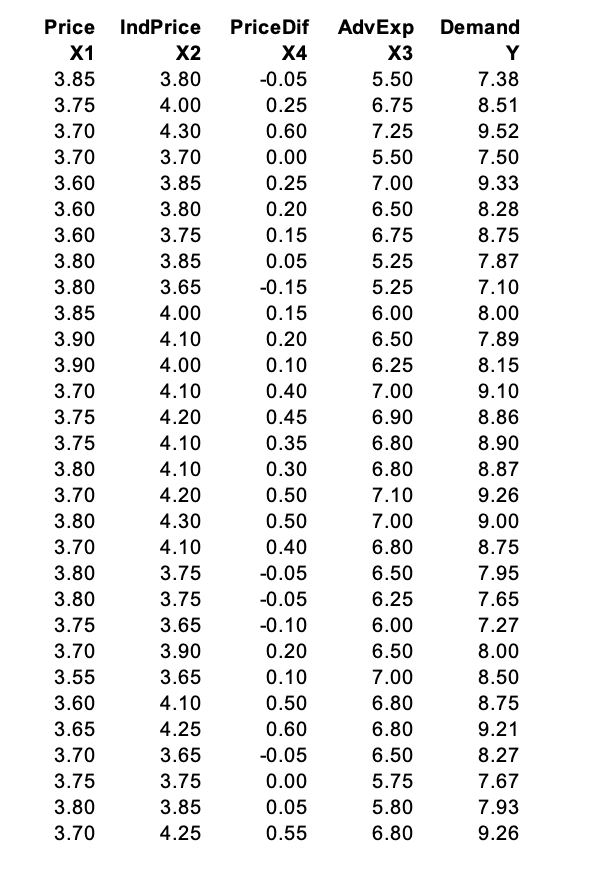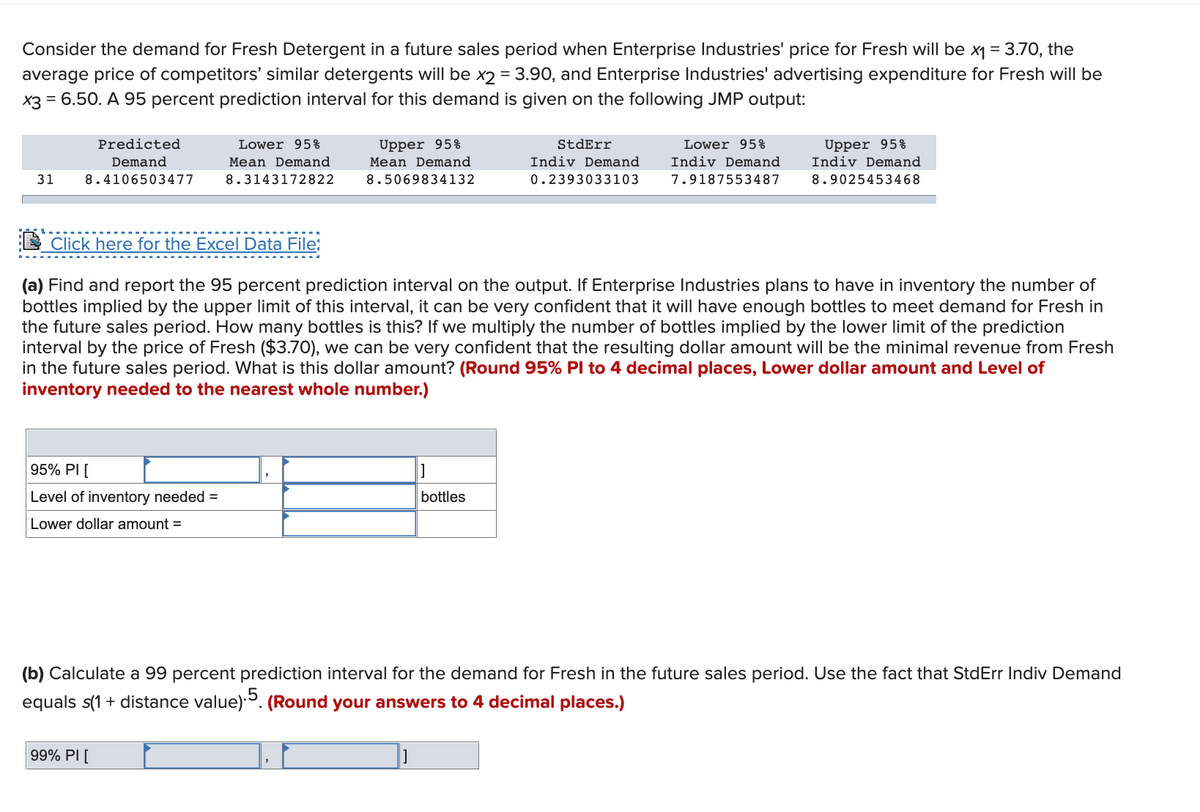Price IndPrice PriceDif AdvExp Demand X1 X2 X4 X3 Y 3.85 3.80 -0.05 5.50 7.38 3.75 4.00 0.25 6.75 8.51 3.70 4.30 0.60 7.25 9.52 3.70 3.70 0.00 5.50 7.50 3.60 3.85 0.25 7.00 9.33 3.60 3.80 0.20 6.50 8.28 3.60 3.75 0.15 6.75 8.75 3.80 3.85 0.05 5.25 7.87 3.80 3.65 -0.15 5.25 7.10 3.85 4.00 0.15 6.00 8.00 3.90 4.10 0.20 6.50 7.89 3.90 4.00 0.10 6.25 8.15 3.70 4.10 0.40 7.00 9.10 3.75 4.20 0.45 6.90 8.86 3.75 4.10 0.35 6.80 8.90 3.80 4.10 0.30 6.80 8.87 3.70 4.20 0.50 7.10 9.26 3.80 4.30 0.50 7.00 9.00 3.70 4.10 0.40 6.80 8.75 3.80 3.75 -0.05 6.50 7.95 3.80 3.75 -0.05 6.25 7.65 3.75 3.65 -0.10 6.00 7.27 3.70 3.90 0.20 6.50 8.00 3.55 3.65 0.10 7.00 8.50 3.60 4.10 0.50 6.80 8.75 3.65 4.25 0.60 6.80 9.21 3.70 3.65 -0.05 6.50 8.27 3.75 3.75 0.00 5.75 7.67 3.80 3.85 0.05 5.80 7.93 3.70 4.25 0.55 6.80 9.26
Price IndPrice PriceDif AdvExp Demand X1 X2 X4 X3 Y 3.85 3.80 -0.05 5.50 7.38 3.75 4.00 0.25 6.75 8.51 3.70 4.30 0.60 7.25 9.52 3.70 3.70 0.00 5.50 7.50 3.60 3.85 0.25 7.00 9.33 3.60 3.80 0.20 6.50 8.28 3.60 3.75 0.15 6.75 8.75 3.80 3.85 0.05 5.25 7.87 3.80 3.65 -0.15 5.25 7.10 3.85 4.00 0.15 6.00 8.00 3.90 4.10 0.20 6.50 7.89 3.90 4.00 0.10 6.25 8.15 3.70 4.10 0.40 7.00 9.10 3.75 4.20 0.45 6.90 8.86 3.75 4.10 0.35 6.80 8.90 3.80 4.10 0.30 6.80 8.87 3.70 4.20 0.50 7.10 9.26 3.80 4.30 0.50 7.00 9.00 3.70 4.10 0.40 6.80 8.75 3.80 3.75 -0.05 6.50 7.95 3.80 3.75 -0.05 6.25 7.65 3.75 3.65 -0.10 6.00 7.27 3.70 3.90 0.20 6.50 8.00 3.55 3.65 0.10 7.00 8.50 3.60 4.10 0.50 6.80 8.75 3.65 4.25 0.60 6.80 9.21 3.70 3.65 -0.05 6.50 8.27 3.75 3.75 0.00 5.75 7.67 3.80 3.85 0.05 5.80 7.93 3.70 4.25 0.55 6.80 9.26
MATLAB: An Introduction with Applications
6th Edition
ISBN:9781119256830
Author:Amos Gilat
Publisher:Amos Gilat
Chapter1: Starting With Matlab
Section: Chapter Questions
Problem 1P
Related questions
Question

Transcribed Image Text:Price
IndPrice PriceDif
AdvExp Demand
X1
X2
X4
X3
Y
3.85
3.80
-0.05
5.50
7.38
3.75
4.00
0.25
6.75
8.51
3.70
4.30
0.60
7.25
9.52
3.70
3.70
0.00
5.50
7.50
3.60
3.85
0.25
7.00
9.33
3.60
3.80
0.20
6.50
8.28
3.60
3.75
0.15
6.75
8.75
3.80
3.85
0.05
5.25
7.87
3.80
3.65
-0.15
5.25
7.10
3.85
4.00
0.15
6.00
8.00
3.90
4.10
0.20
6.50
7.89
3.90
4.00
0.10
6.25
8.15
3.70
4.10
0.40
7.00
9.10
3.75
4.20
0.45
6.90
8.86
3.75
4.10
0.35
6.80
8.90
3.80
4.10
0.30
6.80
8.87
3.70
4.20
0.50
7.10
9.26
3.80
4.30
0.50
7.00
9.00
3.70
4.10
0.40
6.80
8.75
3.80
3.75
-0.05
6.50
7.95
3.80
3.75
-0.05
6.25
7.65
3.75
3.65
-0.10
6.00
7.27
3.70
3.90
0.20
6.50
8.00
3.55
3.65
0.10
7.00
8.50
3.60
4.10
0.50
6.80
8.75
3.65
4.25
0.60
6.80
9.21
3.70
3.65
-0.05
6.50
8.27
3.75
3.75
0.00
5.75
7.67
3.80
3.85
0.05
5.80
7.93
3.70
4.25
0.55
6.80
9.26

Transcribed Image Text:Consider the demand for Fresh Detergent in a future sales period when Enterprise Industries' price for Fresh will be x1 = 3.70, the
average price of competitors' similar detergents will be x2 = 3.90, and Enterprise Industries' advertising expenditure for Fresh will be
x3 = 6.50. A 95 percent prediction interval for this demand is given on the following JMP output:
%3D
Predicted
Lower 95%
Upper 95%
Mean Demand
Upper 95%
Indiv Demand
StdErr
Lower 95%
Demand
Mean Demand
Indiv Demand
Indiv Demand
31
8.4106503477
8.3143172822
8.5069834132
0.2393033103
7.9187553487
8.9025453468
E Click here for the Excel Data File;
(a) Find and report the 95 percent prediction interval on the output. If Enterprise Industries plans to have in inventory the number of
bottles implied by the upper limit of this interval, it can be very confident that it will have enough bottles to meet demand for Fresh in
the future sales period. How many bottles is this? If we multiply the number of bottles implied by the lower limit of the prediction
interval by the price of Fresh ($3.70), we can be very confident that the resulting dollar amount will be the minimal revenue from Fresh
in the future sales period. What is this dollar amount? (Round 95% PI to 4 decimal places, Lower dollar amount and Level of
inventory needed to the nearest whole number.)
95% PI [
Level of inventory needed =
bottles
Lower dollar amount =
(b) Calculate a 99 percent prediction interval for the demand for Fresh in the future sales period. Use the fact that StdErr Indiv Demand
equals s(1 + distance value)5. (Round your answers to 4 decimal places.)
99% PI [
Expert Solution
This question has been solved!
Explore an expertly crafted, step-by-step solution for a thorough understanding of key concepts.
This is a popular solution!
Trending now
This is a popular solution!
Step by step
Solved in 2 steps

Recommended textbooks for you

MATLAB: An Introduction with Applications
Statistics
ISBN:
9781119256830
Author:
Amos Gilat
Publisher:
John Wiley & Sons Inc

Probability and Statistics for Engineering and th…
Statistics
ISBN:
9781305251809
Author:
Jay L. Devore
Publisher:
Cengage Learning

Statistics for The Behavioral Sciences (MindTap C…
Statistics
ISBN:
9781305504912
Author:
Frederick J Gravetter, Larry B. Wallnau
Publisher:
Cengage Learning

MATLAB: An Introduction with Applications
Statistics
ISBN:
9781119256830
Author:
Amos Gilat
Publisher:
John Wiley & Sons Inc

Probability and Statistics for Engineering and th…
Statistics
ISBN:
9781305251809
Author:
Jay L. Devore
Publisher:
Cengage Learning

Statistics for The Behavioral Sciences (MindTap C…
Statistics
ISBN:
9781305504912
Author:
Frederick J Gravetter, Larry B. Wallnau
Publisher:
Cengage Learning

Elementary Statistics: Picturing the World (7th E…
Statistics
ISBN:
9780134683416
Author:
Ron Larson, Betsy Farber
Publisher:
PEARSON

The Basic Practice of Statistics
Statistics
ISBN:
9781319042578
Author:
David S. Moore, William I. Notz, Michael A. Fligner
Publisher:
W. H. Freeman

Introduction to the Practice of Statistics
Statistics
ISBN:
9781319013387
Author:
David S. Moore, George P. McCabe, Bruce A. Craig
Publisher:
W. H. Freeman